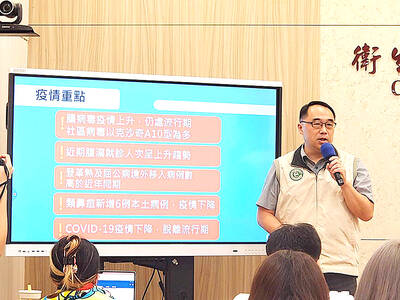Cold War detritus scars the white-sand beach on the island. Concrete barriers meant to halt invading tanks stand sentinel, waiting for an invasion that never came.
In the water, hundreds of rusting, sharpened steel barricades point menacingly toward the bustling Chinese city of Xiamen, whose skyscrapers poke through the midday haze a little more than 4.8km away.
The soldiers who manned the coastal defenses are long gone, though some have been replaced by life-size statues for the benefit of the many tourists who flock to the site. The most imminent danger now is to beachcombers who fail to pick up after their dogs. Signs warn they face a stiff fine: payable in New Taiwan dollars.

Photo: Reuters
Kinmen County’s Lieyu Township (烈嶼), encompassing what is known as Lesser Kinmen Island, is not controlled by the People’s Republic of China, nor is the much larger Kinmen Island nearby, even though both sit on the approaches to one of China’s busiest ports.
The Chinese People’s Liberation Army was never able to wrest control of the strategic islands from former Republic of China leader Chiang Kai-shek (蔣介石), who fled to Taiwan with his Chinese Nationalist Party (KMT) forces in 1949 after losing the Chinese Civil War to Mao Zedong’s (毛澤東) communists.
Chiang, who died in 1975, still watches over the island. A statue of him, doffing his peaked cap, towers over an overgrown athletics field where cows graze. A basketball court and chin-up bars once used by front-line soldiers are slowly surrendering to the lush subtropical vegetation.
Kinmen, formerly called Quemoy, was once a household name in the US. The nationalists and communists engaged in huge artillery duels there in the 1950s, raising tensions among Washington, Beijing and Moscow as then-US president Dwight D. Eisenhower and his secretary of state, John Foster Dulles, vowed to defend Taiwan from attack.
When then-US presidential candidates John F. Kennedy and Richard Nixon were running for head of state in 1960, their disagreement about Quemoy and Matsu, a neighboring archipelago, led to one of the most famous exchanges in their debates.
Now, China and Taiwan exchange volleys of fireworks during the Lunar New Year holiday.
These smaller islands are at a crossroads, borne out by the complicated interplay among the locals, the Taiwanese government and China.
President Tsai Ing-wen’s (蔡英文) Democratic Progressive Party (DPP) took power last month and is focused on the Taiwanese public, who are increasingly uncomfortable with talk over seven decades affirming that Taiwan is part of China.
A poll in February found that 73 percent of Taiwanese surveyed considered themselves Taiwanese, not Chinese, up from 44 percent two decades ago. Among young people, 85 percent consider themselves Taiwanese, the poll found.
Neither Kinmen nor Matsu is geographically part of Taiwan. They are portions of Chinese-controlled Fujian Province that the communists never conquered. Their existence helps to make Taiwan the Republic of China, and people interviewed there, who have prospered as trade and tourism with China have blossomed, have deep ties to China.
“Kinmen people have a very clear sense of their identity,” said Chou Yang-sun (周陽山), a professor who specializes in Chinese affairs at National Quemoy University in Kinmen. “They are Fujianese, but they are also part of the Republic of China — very different from most people in Taiwan, who support independence.”
One such resident is Zhou Ximei, who was born in Fujian’s Ningde County, which from 1988 to 1990 was run by now-Chinese President Xi Jinping (習近平). Zhou married a man from Kinmen, moved there two decades ago and now works in a museum set up in the Jiugong Tunnel, a grotto carved through solid rock to shelter people, boats and supplies during bombardments.
“When you say the Republic of China, there is the word ‘China’ in there as well,” said Zhou, speaking during a lull between boisterous groups of visitors touring the cave. “Chiang Kai-shek came to Taiwan from the mainland, too. I think a good leader needs to seriously ponder if he or she wants Taiwan’s economy to develop and its people to have stable lives.”
Kinmen County prospered as ties between China and Taiwan deepened. In 2001, passenger and trade traffic began between Kinmen and Xiamen. Seven years later, Taiwan opened up direct air, sea and postal links to China. The population in Kinmen boomed, surging to more than 133,000 this year from less than 80,000 a decade ago.
Tourists from China arrive by boat in Kinmen’s port, and a much larger port is being built adjacent to it. A six-story shopping complex, catering to Chinese and billed as Asia’s largest duty-free mall, opened in 2014.
In Taiwan, an hour’s flight away, there has been a different narrative. The economy is contracting and voters who cast their ballots in January, wary that closer ties with China were draining Taiwan of good jobs and giving Beijing more influence, rejected the party that brought better ties with China, Chiang’s own KMT. Tsai leads a party swept into power partly because of concerns about China’s growing shadow over Taiwan.
In December last year, Tsai made a campaign stop in Kinmen, one of the few counties that the DPP wound up losing, and pledged to pour more resources into developing the small islands. As the former head of the government agency that oversees ties with China, she was one of the architects of the “small three links” that in 2001 opened limited passenger, trade and mail connections between Kinmen and Xiamen, and she is not expected to alter the “status quo” that has given such a lift to the local economy.
Despite decades of being on the front lines, including an artillery bombardment that extended more than two decades, people on Kinmen see China not as a threat, but as an opportunity.
In Lieyu, closer ties with China have also had economic consequences, as a massive garrison has dwindled, diminishing a ready market for the island’s shopkeepers.
Soldiers, wearing camouflage uniforms and caps emblazoned with a white sun on a blue field, the national emblem of the Republic of China, mill about the small port where ferries run from Lieyu to China.
However, their small numbers, now in the hundreds, cannot make use of the extensive infrastructure built for the more than 10,000 troops based there decades ago.
Tsai Shu-ta, 59, who, along with his wife, drives a taxi around the less than 15.5km2 that make up Lieyu, recalls the heady days when thousands of soldiers supported a movie theater, whose US-made projector is now on display at a local museum.
Tsai Shu-ta, who has lived his whole life on Lieyu, said he was put off by the DPP’s failure to include Kinmen on its flag — which depicts a green island of Taiwan on a white cross.
He is proud to live in the Republic of China, recalling the propaganda slogans soldiers there broadcast to communist troops across the water. However, he fears a future when Taiwanese might formally move toward independence, which could imperil Kinmen, because Beijing has said that would be grounds for war.
For now, the majority of Taiwanese agree with Tsai Ing-wen that it is best to maintain the “status quo,” the coexistence between the two sides that has kept the peace since the guns finally fell silent in the late 1970s.
If that should ever change, Tsai Shu-ta said, joking and with a chuckle, he has a plan:
“We will return to the mainland,” he said.

A magnitude 4.9 earthquake struck off Tainan at 11:47am today, the Central Weather Administration (CWA) said. The hypocenter was 32.3km northeast of Tainan City Hall at a depth of 7.3km, CWA data showed. The intensity of the quake, which gauges the actual effect of a seismic event, measured 4 in Tainan and Chiayi County on Taiwan's seven-tier intensity scale, the data showed. The quake had an intensity of 3 in Chiayi City and County, and Yunlin County, while it was measured as 2 in Kaohsiung, Nantou County, Changhua County, Taitung County and offshore Penghu County, the data showed. There were no immediate reports of

Weather conditions across Taiwan are expected to remain stable today, but cloudy to rainy skies are expected from tomorrow onward due to increasing moisture in the atmosphere, according to the Central Weather Administration (CWA). Daytime highs today are expected to hit 25-27°C in western Taiwan and 22-24°C in the eastern counties of Yilan, Hualien, and Taitung, data on the CWA website indicated. After sunset, temperatures could drop to 16-17°C in most parts of Taiwan. For tomorrow, precipitation is likely in northern Taiwan as a cloud system moves in from China. Daytime temperatures are expected to hover around 25°C, the CWA said. Starting Monday, areas

The Chinese Nationalist Party (KMT) is maintaining close ties with Beijing, the Democratic Progressive Party (DPP) said yesterday, hours after a new round of Chinese military drills in the Taiwan Strait began. Political parties in a democracy have a responsibility to be loyal to the nation and defend its sovereignty, DPP spokesman Justin Wu (吳崢) told a news conference in Taipei. His comments came hours after Beijing announced via Chinese state media that the Chinese People’s Liberation Army’s Eastern Theater Command was holding large-scale drills simulating a multi-pronged attack on Taiwan. Contrary to the KMT’s claims that it is staunchly anti-communist, KMT Deputy

Taiwan has recorded its first fatal case of Coxsackie B5 enterovirus in 10 years after a one-year-old boy from southern Taiwan died from complications early last month, the Centers for Disease Control (CDC) said yesterday. CDC spokesman Lo Yi-chun (羅一鈞) told a news conference that the child initially developed a fever and respiratory symptoms before experiencing seizures and loss of consciousness. The boy was diagnosed with acute encephalitis and admitted to intensive care, but his condition deteriorated rapidly, and he passed away on the sixth day of illness, Lo said. This also marks Taiwan’s third enterovirus-related death this year and the first severe